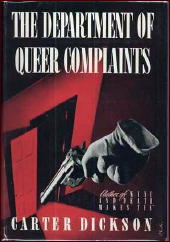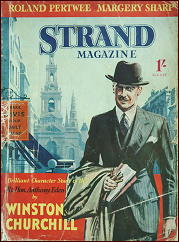Sat 8 May 2010
Mike Tooney Reviews: Two Carter Dickson / John Dickson Carr stories.
Posted by Steve under Reviews[3] Comments

(1) “New Murders for Old” (1939) by Carter Dickson. First appearance: The Illustrated London News, Christmas 1939. First collected in The Department of Queer Complaints (Morrow, 1940). Reprinted in EQMM, August 1966, as “New Murders for Old.” Found in: Alfred Hitchcock Presents 14 of My Favorites in Suspense, 1976.
COMMENTS:
Tony Marvell, on the urging of friends and family, decides to go on an eight-month round-the-world cruise: Tony’s workaholic lifestyle has pushed him to the brink of a nervous breakdown, and his fiancee and brother insist on this rest cure.
“It was the nightmare again. One of the worst features of his nervous breakdown had been the conviction, coming in flashes at night, that he was not real any longer; that his body and his inner self had moved apart, the first walking or talking in everyday life like an articulate dummy, while the brain remained in another place. It was as though he were dead, and seeing his body move. Dead.”
Tony, however, will experience a real shock to the system when he does something few men ever have: read his own obituary in a newspaper. Someone, it seems, wants very badly to see him dead, and if necessary would willingly kill him twice.
“One moment he was standing there with the automatic pistol in his hand, the noise of the engines beating in his ears and a horrible impulse joggling his elbow to put the muzzle of the pistol into his mouth and —”
NOTES:
Dickson/Carr relies on a hoary gimmick to activate the plot, but he still keeps things moving, employing his trademark horror atmospherics but paying it all off with a perfectly rational denouement — although you should be prepared to believe at least two impossible things before breakfast about the character Rupert Hayes.
———

(2) “The Silver Curtain” (1939) by Carter Dickson. First appearance: The Strand, August 1939. First collected in The Department of Queer Complaints (Morrow, 1940); reprinted in Merrivale, March and Murder (IPL, 1991), as by John Dickson Carr. Found in: Tricks and Treats, edited by Joe Gores & Bill Pronzini (Doubleday, 1976).
COMMENTS:
Young Jerry Winton is having rotten luck at the baccara tables. Seeing his difficulties, Ferdie Davos offers Jerry a sizable sum. All he has to do is pick up some pills from a local doctor and collect ten thousand francs: a piece of cake.
But on his way to the rendezvous Jerry witnesses a murder that couldn’t have happened — a man is stabbed to death when nobody else was anywhere near him — an impossible crime, certainly, and one for which the local gendarmes have a prime suspect: Jerry!
“His tan topcoat was now dark with rain. His heels scraped on the pavement, for he had been stabbed through the back of the neck with a heavy knife whose polished-metal handle projected four inches. Then the wallet slipped out of his fingers, and splashed into a puddle, for the man died.”
For the real killer, Jerry fits perfectly in the frame. For Colonel March of Scotland Yard, there really is no mystery, and elucidating this case is all in a day’s — or night’s — work.
NOTES:
Be prepared to accept one or two highly unlikely aspects of the crime (the skill and timing of the murderer); if you buy those, the story should be enjoyable.
Carr adapted this one for radio as “Death Has Four Faces,” but without Colonel March (Appointment with Fear, BBC, October 19, 1944). It was also filmed for the TV series Colonel March of Scotland Yard in 1956 with Boris Karloff as March and a very young Arthur Hill as Jerry. (A video of this episode may be found here.)
May 9th, 2010 at 5:03 pm
Carr is the most playful and game like of the Golden Age writers. You can’t really expect realism on his part, but he played the game grandly if you give him enough rope to trip you up.
If you haven’t seen them the Colonel March series with Boris Karloff are great fun. Karloff plays them with great panache and seems to enjoy himself at every turn. Budgets are small, but they are well written, and Karloff carries them with his playful characterization.
Does anyone recall seeing the ELGIN HOUR production of H. F. Heard’s A TASTE OF HONEY (as STING OF DEATH) with Karloff as Mr. Mycroft? I’ve always wondered if the part was written and played as Sherlock Holmes as in the book or if it was played strictly as horror as in the Hammer film THE DEADLY BEES. Karloff as the older Holmes would be a rare treat.
May 9th, 2010 at 8:31 pm
I’ve just watched the episode that Mike, you sent us to, and David, based on this limited sample of size one, I agree with your assessment of the series totally.
I’d never thought of Boris Karloff in the role of Sherlock Holmes, he’s too much of an icon in his own right, I think, but I’m with you, I’d have loved to have seen him try.
— Steve
May 10th, 2010 at 7:31 pm
Steve
If you know the Heard book and it’s sequel REPLY PAID, the sleuthing is done by “Mr. Mycroft” a retired beekeeper in Sussex and his “Watson.” He’s an older and quite grumpy figure, but I can imagine Karloff having a wonderful time of it playing him as the Holmesian figure he is meant to be.
The Hammer film has something to do with a rock star having a breakdown, and the closest to the Mycroft role is played by Guy Doleman as a rather fierce gentleman farmer, though the name may actually be given to the film’s villain played by Frank Finlay. Pretty dull effort despite a Robert Bloch script.
The same basic plot is also the basis for the classic Anthony Wynne short story “The Cyrian Bees” featuring Dr. Eustace Haley.
Though I haven’t seen them all, I’ve seen several of the Colonel March episodes and Karloff is wonderful in them, droll and playful and quiet good in the scenes where he reveals the killer and explains the complex ‘miracle’ crime. He seems genuinely pleased to be playing something different.